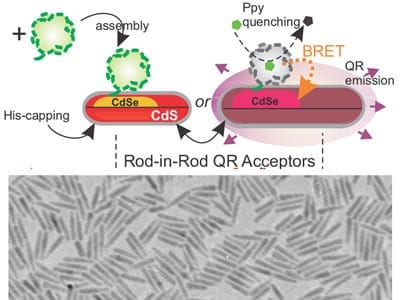
Image: Justin Raymond
Technology developed at MIT can harness temperature fluctuations of many kinds to produce electricity.
Thermoelectric devices, which can generate power when one side of the device is a different temperature from the other, have been the subject of much research in recent years. Now, a team at MIT has come up with a novel way to convert temperature fluctuations into electrical power. Instead of requiring two different temperature inputs at the same time, the new system takes advantage of the swings in ambient temperature that occur during the day-night cycle.
The new system, called a thermal resonator, could enable continuous, years-long operation of remote sensing systems, for example, without requiring other power sources or batteries, the researchers say.
The findings are being reported in the journal Nature Communications, in a paper by graduate student Anton Cottrill, Carbon P. Dubbs Professor of Chemical Engineering Michael Strano, and seven others in MIT’s Department of Chemical Engineering.
“We basically invented this concept out of whole cloth,” Strano says. “We’ve built the first thermal resonator. It’s something that can sit on a desk and generate energy out of what seems like nothing. We are surrounded by temperature fluctuations of all different frequencies all of the time. These are an untapped source of energy.”
While the power levels generated by the new system so far are modest, the advantage of the thermal resonator is that it does not need direct sunlight; it generates energy from ambient temperature changes, even in the shade. That means it is unaffected by short-term changes in cloud cover, wind conditions, or other environmental conditions, and can be located anywhere that’s convenient — even underneath a solar panel, in perpetual shadow, where it could even allow the solar panel to be more efficient by drawing away waste heat, the researchers say.
The thermal resonator was shown to outperform an identically sized, commercial pyroelectric material — an established method for converting temperature fluctuations to electricity — by factor of more than three in terms of power per area, according to Cottrill.
The researchers realized that to produce power from temperature cycles, they needed a material that is optimized for a little-recognized characteristic called thermal effusivity — a property that describes how readily the material can draw heat from its surroundings or release it. Thermal effusivity combines the properties of thermal conduction (how rapidly heat can propagate through a material) and thermal capacity (how much heat can be stored in a given volume of material). In most materials, if one of these properties is high, the other tends to be low. Ceramics, for example, have high thermal capacity but low conduction.
To get around this, the team created a carefully tailored combination of materials. The basic structure is a metal foam, made of copper or nickel, which is then coated with a layer of graphene to provide even greater thermal conductivity. Then, the foam is infused with a kind of wax called octadecane, a phase-change material, which changes between solid and liquid within a particular range of temperatures chosen for a given application.
A sample of the material made to test the concept showed that, simply in response to a 10-degree-Celsius temperature difference between night and day, the tiny sample of material produced 350 millivolts of potential and 1.3 milliwatts of power — enough to power simple, small environmental sensors or communications systems.
“The phase-change material stores the heat,” says Cottrill, the study’s lead author, “and the graphene gives you very fast conduction” when it comes time to use that heat to produce an electric current.
Essentially, Strano explains, one side of the device captures heat, which then slowly radiates through to the other side. One side always lags behind the other as the system tries to reach equilibrium. This perpetual difference between the two sides can then be harvested through conventional thermoelectrics. The combination of the three materials — metal foam, graphene, and octadecane — makes it “the highest thermal effusivity material in the literature to date,” Strano says.
While the initial testing was done using the 24-hour daily cycle of ambient air temperature, tuning the properties of the material could make it possible to harvest other kinds of temperature cycles, such as the heat from the on-and-off cycling of motors in a refrigerator, or of machinery in industrial plants.
“We’re surrounded by temperature variations and fluctuations, but they haven’t been well-characterized in the environment,” Strano says. This is partly because there was no known way to harness them.
Other approaches have been used to try to draw power from thermal cycles, with pyroelectric devices, for example, but the new system is the first that can be tuned to respond to specific periods of temperature variations, such as the diurnal cycle, the researchers say.
These temperature variations are “untapped energy,” says Cottrill, and could be a complementary energy source in a hybrid system that, by combining multiple pathways for producing power, could keep working even if individual components failed. The research was partly funded by a grant from Saudi Arabia’s King Abdullah University of Science and Technology (KAUST), which hopes to use the system as a way of powering networks of sensors that monitor conditions at oil and gas drilling fields, for example.
“They want orthogonal energy sources,” Cottrill says — that is, ones that are entirely independent of each other, such as fossil fuel generators, solar panels, and this new thermal-cycle power device. Thus, “if one part fails,” for example if solar panels are left in darkness by a sandstorm, “you’ll have this additional mechanism to give power, even if it’s just enough to send out an emergency message.”
Such systems could also provide low-power but long-lasting energy sources for landers or rovers exploring remote locations, including other moons and planets, says Volodymyr Koman, an MIT postdoc and co-author of the new study. For such uses, much of the system could be made from local materials rather than having to be premade, he says.
This approach “is a novel development with a great future,” says Kourosh Kalantar-zadeh, a distinguished professor of engineering at RMIT University in Melbourne, Australia, who was not involved in this work. “It can potentially play an unexpected role in complementary energy harvesting units.”
He adds, “To compete with other energy harvesting technologies, always higher voltages and powers are demanded. However, I personally feel that it is quite possible to gain a lot more out of this by investing more into the concept. … It is an attractive technology which will be potentially followed by many others in the near future.”
Learn more: System draws power from daily temperature swings
The Latest on: Thermal resonator
[google_news title=”” keyword=”Thermal resonator” num_posts=”10″ blurb_length=”0″ show_thumb=”left”]
via Google News
The Latest on: Thermal resonator
- A high-fidelity model for designing efficient thermal management surfaceson April 26, 2024 at 11:19 am
In the past decade, fires from electronic devices and batteries, from small smartphones to electrical vehicles and airplanes, have repeatedly made headlines. Enhanced computational power has led to a ...
- Thermal Imagerson April 23, 2024 at 5:00 pm
Billy Goldfeder tells of how preparation with full PPE and SCBA and detailed size-up prevented a firefighter from being injury when an explosion occurred in a communications closet ...
- Thermal Bathson April 22, 2024 at 4:59 pm
A soak in a thermal bath is a quintessential Budapest experience. (It hasn't cultivated a reputation as the "City of Spas" for nothing.) These baths, or fürdok in Hungarian, are heated by natural ...
- SiTime launches clock generators for AI data centerson April 19, 2024 at 10:28 am
SiTime’s Chorus family of clock generators with an integrated resonator delivers 10× higher performance in half the size.
- Bitcoin Spurs Major Renewable Projects From Ocean Thermal To Hydroon April 18, 2024 at 12:52 pm
OceanBit's focus on ocean thermal energy, combined with bitcoin mining, offers a promising solution to the intermittency challenge of renewables. In comparison, Sazmining's utilization of wasted ...
- The 7 Best Thermal Scopes of 2024on April 17, 2024 at 7:02 am
The Sig Sauer ECHO3 is packed with features and won’t completely break the bank. The SNIPE-IR Thermal Clip-On works in conjunction with your regular sight, but can be easily removed if not needed.
- Thermal Batteries: A Clean and Sustainable Alternative to Lithium-Ion Batterieson April 5, 2024 at 1:00 pm
Thermal batteries use heat to store energy, which can be converted into electricity or heat when needed. Thermal batteries are gaining attention as a viable alternative to lithium-ion batteries ...
- These giant batteries store energy, but not as electricityon April 5, 2024 at 5:14 am
Here's a closer look at "thermal batteries." Most of us are familiar with electrochemical energy storage in batteries. Energy can also be stored behind hydroelectric dams (mechanical storage ...
- Intelligent metasurfaces enable ultra-high performance passive radiative coolingon April 4, 2024 at 11:27 am
1). By designing and optimizing the geometry-dependent multiple Mie resonances in the hybrid polar dielectric resonators, the group demonstrated thermal emitters with an emissivity of ~0.92 across ...
- Rare Thermal Vision Footage Shows Cluster Rounds Rain Down on Russian Tankson April 3, 2024 at 2:00 am
New footage appears to show Ukrainian forces wielding thermal vision drones to guide a cluster munitions strike on several Russian armored vehicles in eastern Ukraine. The clip, shared to social ...
via Bing News










